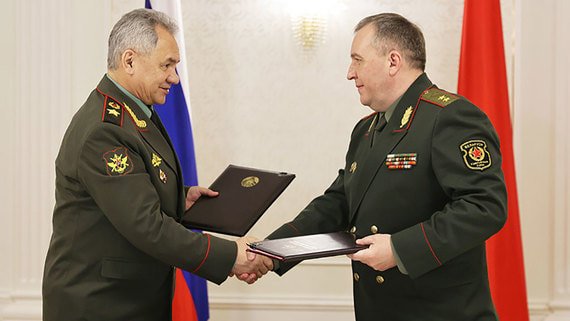Russia and Belarus signed documents on the deployment of nuclear weapons
[ad_1]

Defense Ministers of Russia and Belarus Sergei Shoigu and Viktor Khrenin on May 25 signed documents defining the procedure for keeping Russian nuclear weapons in a special storage facility on the territory of the republic. On the same day, President of Belarus Alexander Lukashenko announced that “the transfer of nuclear weapons” to the territory of his country has begun. According to Shoigu, the documents “comply with all existing international legal obligations.” As reasons for the decision announced in February by President Vladimir Putin to deploy nuclear weapons, Shoigu cited the activity of NATO’s joint nuclear missions, including the training of pilots of non-nuclear countries of the alliance to use American nuclear bombs stored in Europe. The principles of storage of US nuclear weapons in NATO countries have also been applied by Russia, which “does not transfer nuclear weapons to the Republic of Belarus – control over them and the decision to use them remain with the Russian side,” Shoigu emphasized.
The crews of the Iskander missile systems transferred to Belarus and the crews of the Belarusian Su-25 attack aircraft have already undergone preparations for the use of Russian nuclear weapons.
The signed documents define the practice of conditional “joint nuclear missions of the Union State,” says Dmitry Stefanovich, a researcher at IMEMO RAS. Without a formalized order, it is hardly possible to conduct such activities, especially in such a sensitive area.
Such a detailed coverage of, in fact, a technical issue confirms a large symbolic component of what is happening, the expert continues. The parties highlight every new step towards the deployment of Russian nuclear warheads on the territory of Belarus. At the same time, the terms and volumes of the actual placement (if any are fixed somewhere), Stefanovich believes, can be adjusted and revised.
The official and formalized confirmation of Russia’s full control over nuclear weapons should also be welcomed, the expert continues. This does not negate the role of the Belarusian armed forces in supporting possible nuclear operations, similar to the functionality of the forces of non-nuclear NATO countries in relation to US nuclear operations.
Agreements on the deployment of Russian non-strategic nuclear weapons on the territory of Belarus are a common occurrence from the point of view of international legal practice, said Alexander Ermakov, expert of the Russian Council on Foreign Affairs. “The parties spelled out the legal grounds for the location of Russian nuclear facilities, the powers to store them, and the provisions on who is responsible for their use,” the expert said. – Although the issue of the deployment of Russian nuclear weapons in Belarus at the level of doctrine, probably, was decided at the level of the CSTO. Now representatives of the two military departments have recorded technical issues.
In addition to Russia, according to Ermakov, the United States entered into similar agreements, especially during the Cold War. “For example, after an agreement on military cooperation with Denmark, Washington even placed its strategic weapons on its territory in Greenland. The text also discussed technical issues for the storage or use of American weapons. US tactical nuclear weapons abroad are now deployed in Europe. It is located at the Incirlik military base in Turkey, as well as at bases in Belgium, Italy and the Netherlands. Agreements with these countries are more than half a century old,” the expert added.
Russia’s redeployment of part of its nuclear arsenals to Belarus is a warning to Western armies to refrain from direct military intervention in the armed conflict in Ukraine, Yermakov concludes.
[ad_2]
Source link








